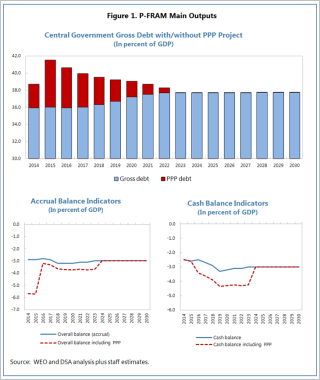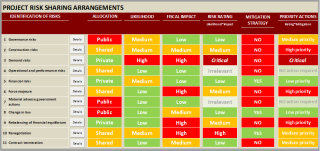Posted by Maximilien Queyranne, Isabel Rial and Genevieve Verdier [1]
The PFRAM, developed by the IMF and the World Bank, is an analytical tool to assess the potential fiscal costs and risks arising from Public-Private Partnership (PPP) projects. PPPs are increasingly promoted as a way to finance investment projects, with the objective of supporting national development goals. However, PPPs are not exempted from controversy. To supporters of PPPs, governments can benefit from efficiency gains derived mainly from the private sector’s technological innovation and superior managerial skills. Critics of PPPs, on the other hand, tend to view PPPs as a procurement option that might weaken fiscal discipline. In their view, many governments have procured investment projects as PPPs not for efficiency reasons, but to circumvent budget constraints and to postpone recording the fiscal costs of providing infrastructure services. Hence, some governments procured projects that either could not be funded within their budgetary envelope, or that exposed public finances to excessive fiscal risks.
Recognizing that PPPs might have significant macro-fiscal implications, the PFRAM tool has been developed to quantify the macro-fiscal implications of PPP projects. Potential users of PFRAM comprise not only IMF and World Bank economists in their work on country surveillance and technical assistance, but also government officials working on PPPs and fiscal risks in ministries of finance.
Based on international accounting and statistical standards and best practices, the PFRAM allows the user to estimate the macro-fiscal implications of PPP projects[2]—i.e., their impact on a country’s fiscal deficit, its gross and net debt, and the stock and flows of contingent liabilities for government. It also provides a framework to identify fiscal risks linked to the risk-sharing arrangements embedded in a PPP project, to evaluate these risks, to discuss appropriate mitigation measures, and to prepare an action plan to implement these measures.
In practice, assessing a PPP project involves both gathering specific project information and making judgments about the government’s role at key stages of the project cycle. PFRAM provides a structured process for gathering information for a PPP project in a simple, user-friendly, Excel-based platform, following a five-steps decision-tree:
- Who initiates the project? The impact of main fiscal indicators (i.e., deficit and debt) varies depending on the public entity ultimately responsible for the project (e.g., central and local governments, state-owned enterprises, etc.).

- Who controls the asset? Simple standardized questions assist the user in making an informed decision about the government’s ability to control the PPP-related asset—either through ownership, beneficial entitlement, or otherwise.
- Who ultimately pays for the asset? The funding structure of the project is what determines its implications on the main fiscal aggregates. PFRAM allows for three funding alternatives: (i) the government pays for the asset using public funds; (ii) the government allows the private sector to collect fees directly from users of the asset (e.g., tolls); and (iii) a combination of the first two alternatives.
- Does the government provide additional support to the private partner? Governments can not only fund PPP projects directly but also support the private partner in a variety of ways, including providing guarantees, equity injections, or tax amnesties.
- What does the allocation of risks through the PPP contract tell us about macro-fiscal risks? Although risk allocation is a centerpiece of structuring a PPP contract, understanding its macro-fiscal implications and the potential need for government actions related to that contract can be, in practice, a challenging task. The PFRAM assists the analyst in identifying the main fiscal risks arising from a contract, and provides a framework for evaluating the likelihood and impact of such risks. It also assesses the need for risk mitigation measures and/or government actions.
PFRAM generates standardized outcomes based on project-specific and macroeconomic data (Figures 1 and 2). These data include: (i) project cash flows; (ii) fiscal tables/charts on a cash and accrual basis; (iii) debt sustainability analysis with and without the PPP project; (iv) analysis of the sensitivity of the main fiscal aggregates to changes in macroeconomic and project-specific parameters; and (v) a summary risk matrix of the project.
Figure 2. Summary Project Risk Matrix (click to enlarge)
The tool and user manual are available for download at:The PFRAM was launched during the World Bank and IMF’s 2016 Spring Meetings in Washington and is currently being test-piloted through technical assistance missions and training activities. A regional workshop was recently organized in Trinidad and Tobago to build capacity in managing the fiscal impact of PPPs. 47 officials from 16 countries in the region were trained on the PFRAM and will be supported in using this new tool to analyze specific PPP projects.
For inquiries, please contact:
[1] Isabel Rial is a Senior Economist in the Public Financial Management Division, Maximilien Queyranne is an Economist, and Genevieve Verdier is Deputy Division Chief in the Public Expenditure Division of the Fiscal Affairs Department, IMF.
[2] PFRAM is based on the standards detailed in the International Public Sector Accounting Standards 32, the IMF’s Government Finance Statistics Manual 2014, and the IMF’s Public Sector Debt Statistics, Guideline for Compilers and Users 2011. It is also based on best fiscal transparency practices as prescribed by the IMF’s Fiscal Transparency Code 2012.
Note: The posts on the IMF PFM Blog should not be reported as representing the views of the IMF. The views expressed are those of the authors and do not necessarily represent those of the IMF or IMF policy.







